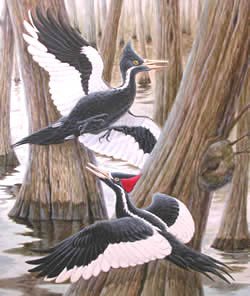 The search for the elusive ivory-billed woodpecker in the swamps of Arkansas has ended for the season with no confirmed sighting, wildlife experts said Thursday, but they plan to start looking again in late autumn.
The search for the elusive ivory-billed woodpecker in the swamps of Arkansas has ended for the season with no confirmed sighting, wildlife experts said Thursday, but they plan to start looking again in late autumn. The "Lord God bird" — so-called because of the exclamation it prompted from those who first saw it — was last officially seen in 1944. But eyewitness reports and a four-second video of the ivory-bill in flight in 2004 convinced many scientists that the crow-sized woodpecker was not extinct, as had been presumed.
An intensive six-month search in the Big Woods of Arkansas failed to turn up any new sightings, bird experts and wildlife officials said. "Certainly, we're somewhat disappointed," said Ron Rohrbaugh, director of Cornell University's search for the bird. "But we have had enough of these kind of tantalizing sounds and possible encounters with birds … that we still have a lot of hope that there might be a pair."
Twenty-two full-time field biologists and 112 volunteers have monitored the birds' probable habitat in eastern Arkansas since December, but the effort ended for the season this month after tree leaves emerged, cutting visibility. The search will resume in late fall, when the trees are again bare. "We're still in high gear; we're still going to keep searching," Rohrbaugh said.
Four people reported seeing birds this season that might have been ivory-billed woodpeckers, but the sightings were so fleeting they could not be confirmed, wildlife experts said. In all four cases, those who allegedly saw them reported the characteristic band of white at the trailing edge of the bird's wings. The more common pileated woodpecker, found in much of the United States, is about the same size as the ivory-bill but lacks the white swath. Aside from using human observers, searchers installed remote microphones and cameras in the Big Woods. Scientists at Cornell's Lab of Ornithology will review the thousands of hours of these recordings for possible signs of the bird. (from Reuters)
No comments:
Post a Comment